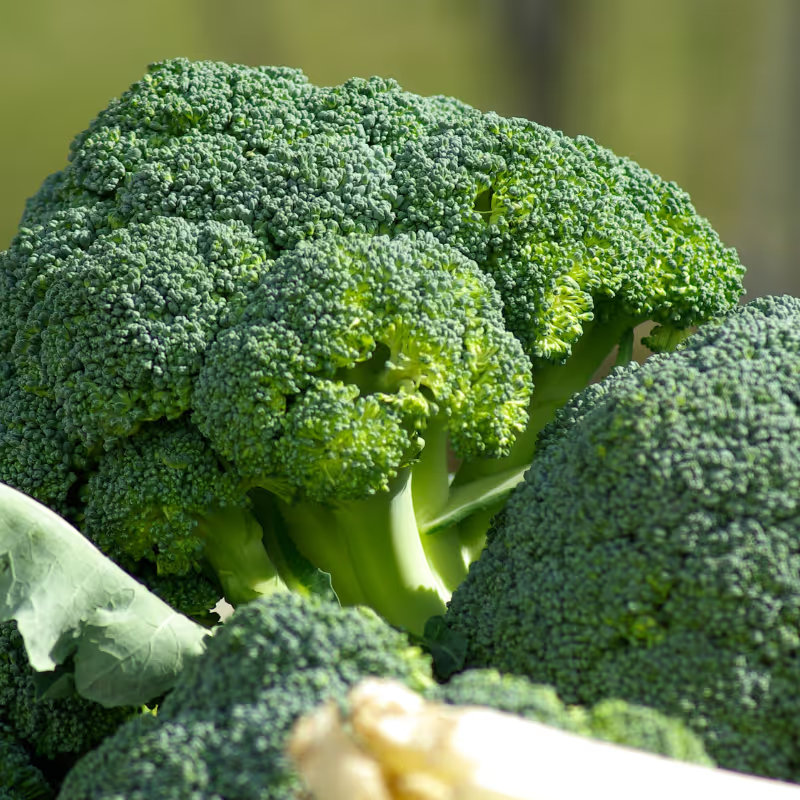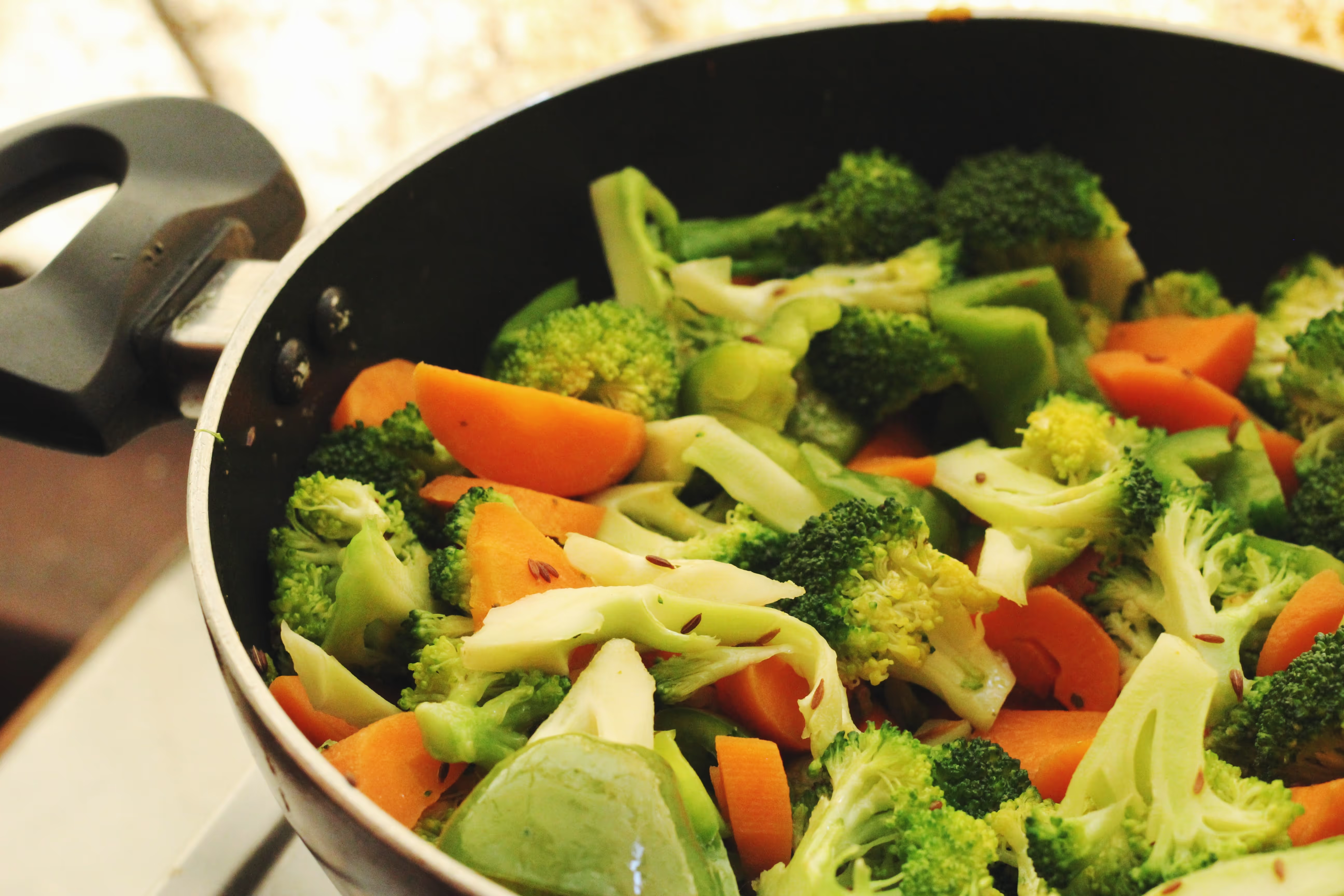What Does it Taste Like?
Broccoli offers a slightly bitter, earthy flavor with subtle hints of sweetness. The texture is delightfully varied: the florets are tender yet crisp when cooked, while the stems provide a satisfying crunch. Raw broccoli has a more pronounced crunch and a sharper taste, which mellows considerably with cooking.
Varieties we grow

Gyspy
This variety is known for its uniform, dark green florets and tender stems. It has a milder, sweeter flavor compared to other varieties, making it a versatile choice for various dishes.
Why Should I Eat It?
- Immunity Boost: This may come as a surprise, but a cup of broccoli contains more vitamin C than a whole orange! Vitamin C can help your body fight off infections.
- Vitamin Rich: In addition to vitamin C, broccoli also contains a lot of vitamin K, folate and potassium. These help support a healthy blood pressure and healthy cell growth.
- Antioxidants: Broccoli contains potent antioxidants that can protect your cells from damage caused by free radicals, which are harmful molecules that can cause inflammation and chronic diseases. Some of the antioxidants in broccoli are sulforaphane, lutein and zeaxanthin.
Broccoli

July - December
Broccoli, often celebrated as a staple in healthy eating, boasts a striking appearance with its vibrant green florets and sturdy stalks. This cruciferous vegetable, a relative of cabbage and cauliflower, is both versatile and nutritious, making it a favorite in kitchens around the world.
Recommended Storage
How Do I Store It?
Short Term
Keep broccoli in a loosely wrapped or perforated bag in the refrigerator, preferably in the crisper drawer. This will allow some air circulation and prevent excess moisture from spoiling the broccoli. Don't wash before storing it, as this can promote mold growth. You should also keep the broccoli away from fruits that produce ethylene gas, such as apples, as this can speed up the ripening and decay of the broccoli. Refrigerated broccoli can last for 3 to 5 days.
Long Term
- Freezing: This is the best way to preserve broccoli for a long time and retain its nutrients and color. You should blanch the broccoli before freezing it, which means boiling it briefly and then plunging it into ice water. This will stop the enzyme activity that causes the broccoli to lose its quality and flavor. You should then drain the broccoli well and spread it on a baking sheet. Freeze the broccoli until solid and then transfer it to a labeled freezer-safe bag. Frozen broccoli can last for 10 to 12 months.
- Pickling: Broccoli can be pickled on it's own or combined with other veggies (called a giardiniera). The florets do best in a quick pickle, but if your doing a traditional pickle, stick to using the stalks. The delicate florets will turn to mush while processing a traditional pickle.
- Dehydrating: Dehydrated broccoli chips are a fantastic crunchy snack. You can season them with salt, pepper, garlic or onion powder, ginger, or even a little chili powder for a spicy kick.
Whatever you do, don't try to can your broccoli! The high tempuratures in the canning process will turn your broccoli to goo. There's a reason you don't see canned broccoli on the supermarket shelves.
How Do I Cook It?

There are many ways to cook broccoli, but some methods are better than others in terms of flavor, texture, nutrition, and convenience. Here are some of the best methods for cooking broccoli:
- Roasting: This is definitely my personal favorite! Roasting the broccoli in a high-temperature oven gives it beautifully caramelized edges and a crispy texture. It’s sweet, rich and almost creamy. It tastes good in just about everything, from sheet pan dinners to using it as a pizza topping. To roast broccoli, preheat the oven to 425°F. Cut the broccoli into florets and toss them with oil, salt, pepper, and any other seasonings you like. Spread them in a single layer on a baking sheet and roast for 15 to 20 minutes, flipping halfway, until golden and tender.
- Sautéing: This method is quick and easy, and it allows you to customize the flavor of your broccoli with different ingredients. Sautéing also preserves the crunch and color of the broccoli, while adding some browning and caramelization. To sauté broccoli, heat some oil in a large skillet over medium-high heat. Add the broccoli florets and cook, stirring occasionally, for about 10 minutes, until crisp-tender. You can also add garlic, onion, ginger, soy sauce, lemon juice, or any other flavors you like.
- Steaming: This is the most classic way to cook broccoli, and it’s also one of the healthiest. Steaming sets broccoli’s color and unlocks its nutrients, but it also cooks the vegetable all the way through. But, because the broccoli never touches the water, steaming also allows the veggie to retain its water-soluble vitamins during the process. Steaming is perfect for making side dishes, pasta or rice bowls. To steam broccoli place a steamer basket full of broccoli in a pot with an inch of boiling water. Cook over high heat with the lid on for about 5 minutes.
- Blanching: This method is similar to steaming, but it involves briefly boiling the broccoli and then plunging it into ice water to stop the cooking process. Blanching is the best method to lock-in broccoli’s stand-out color. Since it doesn’t cook the broccoli all the way through—just until it’s tender-crisp—this method is ideal for preparing broccoli for the freezer if you bought too much. It’s also perfect for veggie platters, salads or casseroles. To blanch broccoli, bring a large pot of water to a boil and add a pinch of salt. Add the broccoli florets in batches and cook for 15 to 30 seconds, until the color turns bright green. Remove the broccoli to an ice bath using a slotted spoon and continue blanching until all the broccoli is cooked.
Recommended Recipes
What Goes Well With It?
- Cheese: Cheese and broccoli are a classic combination that can make any dish more creamy and satisfying. You can use cheese to make a sauce, a gratin, a casserole, or a mac and cheese with broccoli. Some of the best cheeses to pair with broccoli are cheddar, parmesan, feta, goat, and mozzarella.
- Lemon: Lemon and broccoli are a refreshing and bright pairing that can enhance the flavor and color of the vegetable. You can use lemon juice, zest, or slices to add a zesty touch to your broccoli. Lemon goes well with roasted, steamed, or sautéed broccoli, and can also be mixed with butter, garlic, or herbs for a simple and delicious sauce.
- Garlic: Garlic and broccoli are a savory and aromatic pairing that can add depth and richness to your broccoli. You can use garlic in various forms, such as minced, granules, powder, or roasted, to flavor your broccoli. Garlic goes well with any cooking method, and can also be combined with other ingredients, such as olive oil, soy sauce, cheese, or nuts, for a more complex flavor³.
- Ginger: Ginger and broccoli are a spicy and exotic pairing that can give your broccoli an Asian twist. You can use ginger powder or fresh ginger to spice up your broccoli. Ginger goes well with stir-fried, steamed, or roasted broccoli, and can also be paired with other ingredients, such as soy sauce, sesame oil, honey, or lime, for a sweet and tangy sauce.
- Nuts: Nuts and broccoli are a crunchy and nutty pairing that can add texture and protein to your broccoli. Some of the best nuts to pair with broccoli are almonds, cashews, walnuts, and pine nuts.
- Bacon: Broccoli and bacon are a smoky and salty pairing that can make a dish a little more kid-friendly if you have a picky eater. They're often cooked together in a skillet, where the bacon fat renders and coats the broccoli florets, giving them a crispy and savory coating. This pairing can be enjoyed as a side dish, a salad, a pizza topping, or a quiche filling.
